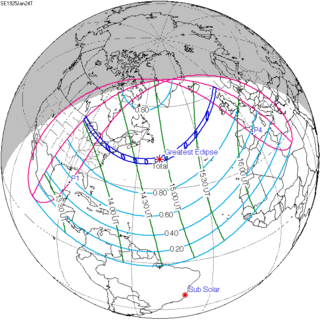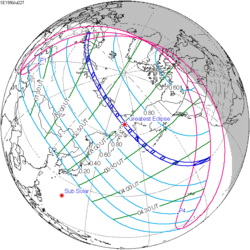Top Qs
Timeline
Chat
Perspective
Solar eclipse of January 24, 1925
Total eclipse From Wikipedia, the free encyclopedia
Remove ads
A total solar eclipse occurred at the Moon's descending node of orbit on Saturday, January 24, 1925,[1] with a magnitude of 1.0304. A solar eclipse occurs when the Moon passes between Earth and the Sun, thereby totally or partly obscuring the image of the Sun for a viewer on Earth. A total solar eclipse occurs when the Moon's apparent diameter is larger than the Sun's, blocking all direct sunlight, turning day into darkness. Totality occurs in a narrow path across Earth's surface, with the partial solar eclipse visible over a surrounding region thousands of kilometres wide. Occurring about 1.1 days after perigee (on January 23, 1925, at 13:30 UTC), the Moon's apparent diameter was larger.[2]
Totality was visible from southwestern and southeastern Ontario in Canada (including Toronto and Niagara Falls), Minnesota, Wisconsin, Michigan, Pennsylvania, New York (including the northern part of New York City), New Jersey, Connecticut, Rhode Island, and Massachusetts. A partial eclipse was visible for parts of North America, Central America, the Caribbean, northern South America, West Africa, and Western Europe.
Remove ads
Observations

It was seen in New York City. It was reported that those north of 96th Street in Manhattan saw a total solar eclipse while those south of 96th Street saw a partial eclipse.[3]
Visual and radio observations were conducted by researchers working with Scientific American.[4]
Eclipse details
Summarize
Perspective
Shown below are two tables displaying details about this particular solar eclipse. The first table outlines times at which the Moon's penumbra or umbra attains the specific parameter, and the second table describes various other parameters pertaining to this eclipse.[5]
Remove ads
Eclipse season
This eclipse is part of an eclipse season, a period, roughly every six months, when eclipses occur. Only two (or occasionally three) eclipse seasons occur each year, and each season lasts about 35 days and repeats just short of six months (173 days) later; thus two full eclipse seasons always occur each year. Either two or three eclipses happen each eclipse season. In the sequence below, each eclipse is separated by a fortnight.
Related eclipses
Eclipses in 1925
- A total solar eclipse on January 24.
- A partial lunar eclipse on February 8.
- An annular solar eclipse on July 20.
- A partial lunar eclipse on August 4.
Metonic
- Preceded by: Solar eclipse of April 8, 1921
- Followed by: Solar eclipse of November 12, 1928
Tzolkinex
- Preceded by: Solar eclipse of December 14, 1917
- Followed by: Solar eclipse of March 7, 1932
Half-Saros
- Preceded by: Lunar eclipse of January 20, 1916
- Followed by: Lunar eclipse of January 30, 1934
Tritos
- Preceded by: Solar eclipse of February 25, 1914
- Followed by: Solar eclipse of December 25, 1935
Solar Saros 120
- Preceded by: Solar eclipse of January 14, 1907
- Followed by: Solar eclipse of February 4, 1943
Inex
- Preceded by: Solar eclipse of February 13, 1896
- Followed by: Solar eclipse of January 5, 1954
Triad
- Preceded by: Solar eclipse of March 25, 1838
- Followed by: Solar eclipse of November 25, 2011
Solar eclipses of 1924–1928
This eclipse is a member of a semester series. An eclipse in a semester series of solar eclipses repeats approximately every 177 days and 4 hours (a semester) at alternating nodes of the Moon's orbit.[6]
The partial solar eclipses on March 5, 1924 and August 30, 1924 occur in the previous lunar year eclipse set, and the solar eclipses on May 19, 1928 and November 12, 1928 occur in the next lunar year eclipse set.
Saros 120
This eclipse is a part of Saros series 120, repeating every 18 years, 11 days, and containing 71 events. The series started with a partial solar eclipse on May 27, 933 AD. It contains annular eclipses from August 11, 1059 through April 26, 1492; hybrid eclipses from May 8, 1510 through June 8, 1564; and total eclipses from June 20, 1582 through March 30, 2033. The series ends at member 71 as a partial eclipse on July 7, 2195. Its eclipses are tabulated in three columns; every third eclipse in the same column is one exeligmos apart, so they all cast shadows over approximately the same parts of the Earth.
The longest duration of annularity was produced by member 11 at 6 minutes, 24 seconds on September 11, 1113, and the longest duration of totality was produced by member 60 at 2 minutes, 50 seconds on March 9, 1997. All eclipses in this series occur at the Moon’s descending node of orbit.[7]
Metonic series
The metonic series repeats eclipses every 19 years (6939.69 days), lasting about 5 cycles. Eclipses occur in nearly the same calendar date. In addition, the octon subseries repeats 1/5 of that or every 3.8 years (1387.94 days). All eclipses in this table occur at the Moon's descending node.
Tritos series
This eclipse is a part of a tritos cycle, repeating at alternating nodes every 135 synodic months (≈ 3986.63 days, or 11 years minus 1 month). Their appearance and longitude are irregular due to a lack of synchronization with the anomalistic month (period of perigee), but groupings of 3 tritos cycles (≈ 33 years minus 3 months) come close (≈ 434.044 anomalistic months), so eclipses are similar in these groupings.
Inex series
This eclipse is a part of the long period inex cycle, repeating at alternating nodes, every 358 synodic months (≈ 10,571.95 days, or 29 years minus 20 days). Their appearance and longitude are irregular due to a lack of synchronization with the anomalistic month (period of perigee). However, groupings of 3 inex cycles (≈ 87 years minus 2 months) comes close (≈ 1,151.02 anomalistic months), so eclipses are similar in these groupings.
Remove ads
See also
Notes
References
Further reading
External links
Wikiwand - on
Seamless Wikipedia browsing. On steroids.
Remove ads





































































































